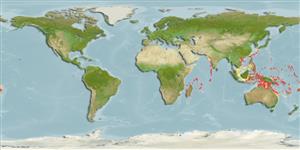Environment: milieu / climate zone / depth range / distribution range
Ekologi
laut berasosiasi dengan karang; kisaran kedalaman 3 - 50 m (Ref. 90102). Tropical
Indo-Pacific: Chagos Archipelago and Maldives; non-types from the Great Barrier Reef, Fiji, New Guinea, and the Philippines.
Size / Weight / umur
Maturity: Lm ? range ? - ? cm
Max length : 2.1 cm SL jantan/; (Ref. 9360)
Duri punggung (Keseluruhan (total)): 6 - 7; duri punggung lunak (Keseluruhan (total)): 8-9; Duri dubur 1; Sirip dubur lunak: 8. Characterized by semi-translucent with orange/brown scale margins; three large orange to brown blotches behind pectoral fin; head with large dusky orange spots/bands; pectoral fin base with a pair of large brown to reddish spots on pectoral fin base; small dark spots present on dorsal and caudal fin rays; absence of pelvic frenum; branched caudal rays 12; longitudinal scale series 25-26; ctenoid scales on body except cycloid near midline of abdomen; head, nape, pectoral fin base and breast scaleless; depth of body 5.0-5.5 in SL (Ref. 90102).
Inhabits reef crevices (Ref. 90102).
"The entire reproductive sequence consisted of nest preparation by a male, courtship behaviors, nest entry by a female, spawning, and paternal care until the hatching of eggs." The sequence of behavior observed during courtship in the laboratory were as follows: "The male approached a female. The female responded to the male approach with yawning. In leading, the male returned to its nest. Tail-waving was performed during stopping." (Ref. 58424).
Randall, J.E. and M. Goren, 1993. A review of the gobioid fishes of the Maldives. Ichthyol. Bull. J.L.B. Smith Inst. Ichthyol. (58):1-37, 5 pls. (Ref. 9360)
Status IUCN Red List (Ref. 130435)
ancaman kepada manusia
Harmless
penggunaan manusia
informasi lanjut
AcuanBudidaya airprofil budidaya airStrainGenetikaElectrophoresesDiturunkanPenyakit-penyakitPengolahanNutrientsMass conversion
mitraGambarStamps, Coins Misc.Suara-suaraCiguateraKecepatanTipe renangArea insangOtolithsOtakPenglihatan / visi
Alat, peralatan
laporan khas
muat turun XML
Sumber internet
Estimates based on models
Preferred temperature (Ref.
123201): 26.2 - 28.9, mean 27.6 °C (based on 282 cells).
Phylogenetic diversity index (Ref.
82804): PD
50 = 0.5078 [Uniqueness, from 0.5 = low to 2.0 = high].
Bayesian length-weight: a=0.01023 (0.00477 - 0.02194), b=3.02 (2.84 - 3.20), in cm total length, based on LWR estimates for this (Sub)family-body shape (Ref.
93245).
Trophic level (Ref.
69278): 3.1 ±0.3 se; based on size and trophs of closest relatives
Daya lenting (Ref.
120179): Rendah, Waktu penggandaan populasi minimum 4.5 - 14 tahun (Fec = 34).
Fishing Vulnerability (Ref.
59153): Low vulnerability (10 of 100).
Nutrients (Ref.
124155): Calcium = 394 [164, 1,382] mg/100g; Iron = 1.87 [0.79, 4.27] mg/100g; Protein = 18 [16, 20] %; Omega3 = 0.177 [0.054, 0.580] g/100g; Selenium = 37.4 [10.8, 108.5] μg/100g; VitaminA = 113 [22, 582] μg/100g; Zinc = 4.96 [2.60, 8.41] mg/100g (wet weight);
